List of mammals of Albania
Today, List of mammals of Albania is a topic that has captured the attention of millions of people around the world. With its relevance in the social, political, cultural and economic spheres, List of mammals of Albania has become a constant presence in our lives. Whether through technological advances, changes in government policies, or simply its impact on the way we interact with each other, List of mammals of Albania continues to be a topic of interest and debate. In this article, we will explore the impact and importance of List of mammals of Albania in today's society, and how its influence has shaped our present and future.
This list shows the IUCN Red List status of the 58 mammal species occurring in Albania. One of them is endangered, one is vulnerable, and four are near threatened. The following tags are used to highlight each species' status as published by the International Union for Conservation of Nature:
| EX | Extinct | No reasonable doubt that the last individual has died. |
| EW | Extinct in the wild | Known only to survive in captivity or as a naturalized populations well outside its previous range. |
| CR | Critically endangered | The species is in imminent risk of extinction in the wild. |
| EN | Endangered | The species is facing an extremely high risk of extinction in the wild. |
| VU | Vulnerable | The species is facing a high risk of extinction in the wild. |
| NT | Near threatened | The species does not meet any of the criteria that would categorise it as risking extinction but it is likely to do so in the future. |
| LC | Least concern | There are no current identifiable risks to the species. |
| DD | Data deficient | There is inadequate information to make an assessment of the risks to this species. |
Order: Rodentia (rodents)

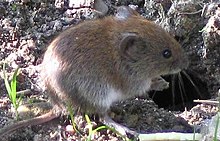
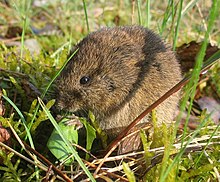
Rodents make up the largest order of mammals, with over 40 percent of mammalian species. They have two incisors in the upper and lower jaw which grow continually and must be kept short by gnawing.
- Suborder: Sciurognathi
- Family: Gliridae (dormice)
- Subfamily: Leithiinae
- Genus: Muscardinus
- Hazel dormouse, Muscardinus avellanarius LC
- Genus: Muscardinus
- Subfamily: Leithiinae
- Family: Cricetidae
- Subfamily: Arvicolinae
- Genus: Arvicola
- Water vole, Arvicola terrestris LC
- Genus: Clethrionomys
- Bank vole, Clethrionomys glareolus LC
- Genus: Microtus
- Common vole, Microtus arvalis LC
- Felten's vole, Microtus felteni LC
- European pine vole, Microtus subterraneus LC
- Thomas's pine vole, Microtus thomasi LC
- Genus: Arvicola
- Subfamily: Arvicolinae
- Family: Muridae (mice, rats, voles, gerbils, hamsters, etc.)
- Subfamily: Murinae
- Genus: Apodemus
- Yellow-necked mouse, Apodemus flavicollis LC
- Broad-toothed field mouse, Apodemus mystacinus LC
- Wood mouse, Apodemus sylvaticus LC
- Genus: Apodemus
- Subfamily: Murinae
- Family: Gliridae (dormice)
Order: Lagomorpha (lagomorphs)
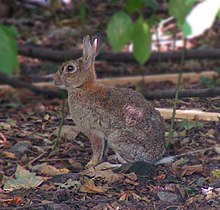
The lagomorphs comprise two families, Leporidae (hares and rabbits), and Ochotonidae (pikas). Though they can resemble rodents, and were classified as a superfamily in that order until the early 20th century, they have since been considered a separate order. They differ from rodents in a number of physical characteristics, such as having four incisors in the upper jaw rather than two.
- Family: Leporidae (rabbits, hares)
- Genus: Lepus
- European hare, L. europaeus LC
- Genus: Oryctolagus
- European rabbit, O. cuniculus EN introduced
- Genus: Lepus
Order: Erinaceomorpha (hedgehogs and gymnures)
The order Erinaceomorpha contains a single family, Erinaceidae, which comprise the hedgehogs and gymnures. The hedgehogs are easily recognised by their spines while gymnures look more like large rats.
- Family: Erinaceidae (hedgehogs)
- Subfamily: Erinaceinae
- Genus: Erinaceus
- Southern white-breasted hedgehog, E. concolor LC
- Genus: Erinaceus
- Subfamily: Erinaceinae
Order: Soricomorpha (shrews, moles, and solenodons)

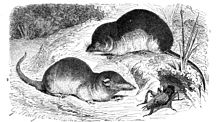
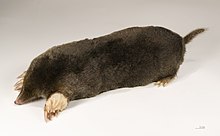
The "shrew-forms" are insectivorous mammals. The shrews and solenodons closely resemble mice while the moles are stout-bodied burrowers.
- Family: Soricidae (shrews)
- Subfamily: Crocidurinae
- Genus: Crocidura
- Bicolored shrew, C. leucodon LC
- Lesser white-toothed shrew, C. suaveolens LC
- Genus: Suncus
- Etruscan shrew, Suncus etruscus LC
- Genus: Crocidura
- Subfamily: Soricinae
- Tribe: Nectogalini
- Genus: Neomys
- Southern water shrew, Neomys anomalus LC
- Eurasian water shrew, Neomys fodiens LC
- Genus: Neomys
- Tribe: Soricini
- Genus: Sorex
- Alpine shrew, Sorex alpinus LC
- Common shrew, Sorex araneus LC
- Eurasian pygmy shrew, Sorex minutus LC
- Genus: Sorex
- Tribe: Nectogalini
- Subfamily: Crocidurinae
- Family: Talpidae (moles)
- Subfamily: Talpinae
- Tribe: Talpini
- Genus: Talpa
- Mediterranean mole, Talpa caeca LC
- European mole, Talpa europaea LC
- Stankovic's mole, Talpa stankovici LC
- Genus: Talpa
- Tribe: Talpini
- Subfamily: Talpinae
Order: Chiroptera (bats)

The bats' most distinguishing feature is that their forelimbs are developed as wings, making them the only mammals capable of flight. Bat species account for about 20% of all mammals. In Albania, 32 species were recorded.
- Family: Vespertilionidae
- Subfamily: Myotinae
- Genus: Myotis
- Alcathoe bat, M. alcathoe DD
- Brandt's bat, M. brandti LC
- Bechstein's bat, M. bechsteini NT
- Lesser mouse-eared bat, M. blythii LC
- Long-fingered bat, M. capaccinii VU
- Daubenton's bat, M. daubentonii LC
- Geoffroy's bat, M. emarginatus LC
- Greater mouse-eared bat, M. myotis LC
- Whiskered bat, M. mystacinus LC
- Natterer's bat, M. nattereri LC
- Genus: Myotis
- Subfamily: Vespertilioninae
- Genus: Eptesicus
- Serotine bat, Eptesicus serotinus LC
- Genus: Nyctalus
- Greater noctule bat, N. lasiopterus NT
- Lesser noctule, N. leisleri LC
- Common noctule, N. noctula LC
- Genus: Pipistrellus
- Nathusius' pipistrelle, P. nathusii LC
- Kuhl's pipistrelle, Pipistrellus kuhlii LC
- Common pipistrelle, Pipistrellus pipistrellus LC
- Soprano pipistrelle, Pipistrellus pygmaeus
- Genus: Hypsugo
- Savi's pipistrelle, H. savii LC
- Genus: Vespertilio
- Parti-coloured bat, Vespertilio murinus
- Genus: Barbastella
- Western barbastelle, Barbastella barbastellus
- Genus: Plecotus
- Alpine long-eared bat, P. macrobullaris NT
- Grey long-eared bat, P. austriacus LC
- Brown long-eared bat, P. auritus LC
- Kolombatovic's long-eared bat, P. kolombatovici
- Subfamily: Miniopterinae
- Genus: Miniopterus
- Common bent-wing bat, M. schreibersii VU
- Genus: Tadarida
- European free-tailed bat, Tadarida teniotis LC
- Genus: Eptesicus
- Family: Rhinolophidae
- Subfamily: Rhinolophinae
- Genus: Rhinolophus
- Blasius's horseshoe bat, R. blasii LC
- Lesser horseshoe bat, Rhinolophus hipposideros LC
- Greater horseshoe bat, Rhinolophus ferrumequinum LC
- Mediterranean horseshoe bat, Rhinolophus euryale LC
- Mehely's horseshoe bat, Rhinolophus mehelyi LC
- Genus: Rhinolophus
- Subfamily: Rhinolophinae
- Subfamily: Myotinae
Order: Cetacea (whales)

The order Cetacea includes whales, dolphins and porpoises. They are the mammals most fully adapted to aquatic life with a spindle-shaped nearly hairless body, protected by a thick layer of blubber, and forelimbs and tail modified to provide propulsion underwater.
- Suborder: Mysticeti
- Family: Balaenopteridae
- Genus: Balaenoptera
- Fin whale, B. physalus EN
- Genus: Balaenoptera
- Family: Balaenopteridae
- Suborder: Odontoceti
- Superfamily: Platanistoidea
- Family: Delphinidae (marine dolphins)
- Genus: Delphinus
- Short-beaked common dolphin, Delphinus delphis LC
- Genus: Grampus
- Risso's dolphin, Grampus griseus DD
- Genus: Orcinus
- Killer whale, Orcinus orca DD
- Genus: Delphinus
- Family: Delphinidae (marine dolphins)
- Superfamily: Platanistoidea
Order: Carnivora (carnivorans)


There are over 260 species of carnivorans, the majority of which feed primarily on meat. They have a characteristic skull shape and dentition.
- Suborder: Feliformia
- Family: Felidae (cats)
- Subfamily: Felinae
- Genus: Felis
- European wildcat, F. silvestris LC
- Genus: Lynx
- Eurasian lynx, L. lynx LC
- Genus: Felis
- Subfamily: Felinae
- Family: Felidae (cats)
- Suborder: Caniformia
- Family: Canidae (dogs, foxes)
- Genus: Canis
- Golden jackal, C. aureus LC
- European jackal, C. a. moreoticus
- Gray wolf, C. lupus LC
- Eurasian wolf, C. l. lupus
- Golden jackal, C. aureus LC
- Genus: Vulpes
- Red fox, V. vulpes LC
- Genus: Canis
- Family: Ursidae (bears)
- Genus: Ursus
- Brown bear, U. arctos LC
- Eurasian brown bear, U. a. arctos
- Brown bear, U. arctos LC
- Genus: Ursus
- Family: Mustelidae (mustelids)
- Genus: Lutra
- European otter, L. lutra NT
- Genus: Martes
- Beech marten, M. foina LC
- European pine marten, M. martes LC
- Genus: Meles
- European badger, M. meles LC
- Genus: Mustela
- Stoat, M. erminea LC
- Least weasel, M. nivalis LC
- European polecat, M. putorius LC
- Genus: Lutra
- Family: Phocidae (earless seals)
- Genus: Monachus
- Mediterranean monk seal, M. monachus EN possibly extirpated
- Genus: Monachus
- Family: Canidae (dogs, foxes)
Order: Artiodactyla (even-toed ungulates)

The even-toed ungulates are ungulates whose weight is borne about equally by the third and fourth toes, rather than mostly or entirely by the third as in perissodactyls. There are about 220 artiodactyl species, including many that are of great economic importance to humans.
- Family: Suidae (pigs)
- Family: Cervidae (deer)
- Subfamily: Capreolinae
- Subfamily: Cervinae
- Genus: Dama
- European fallow deer, D. dama LC
- Genus: Dama
- Family: Bovidae (cattle, antelope, sheep, goats)
See also
- List of chordate orders
- Lists of mammals by region
- List of prehistoric mammals
- Mammal classification
- List of mammals described in the 2000s
References
- ^ Hacklande, K.; Schai-Braun, S. (2019). "Lepus europaeus". IUCN Red List of Threatened Species. 2019: e.T41280A45187424. doi:10.2305/IUCN.UK.2019-1.RLTS.T41280A45187424.en.
- ^ Hutterer, R.; Amori, G.; Krystufek, B.; Yigit, N.; Mitsain, G. & Palomo, L.J. (2010). "Crocidura suaveolens". IUCN Red List of Threatened Species. 2010: e.T29656A9511068.
- ^ Hutson, A.M. & Paunović, M. (2016). "Myotis alcathoe". IUCN Red List of Threatened Species. 2016: e.T136680A518740.
- ^ Gazaryan, S.; Kruskop, S.V. & Godlevska, L. (2020). "Myotis brandtii". IUCN Red List of Threatened Species. 2020: e.T85566997A22054468.
- ^ Paunović, M. (2019). "Myotis bechsteinii". IUCN Red List of Threatened Species. 2019: e.T14123A22053752.
- ^ Juste, J. & Paunović, M. (2016). "Myotis blythii". IUCN Red List of Threatened Species. 2016: e.T14124A22053297.
- ^ Hutson, A. M.; Spitzenberger, F.; Aulagnier, S.; Juste, J.; Karatas, A.; Palmeirim, J. & Paunovic, M. (2010). "Myotis capaccinii". IUCN Red List of Threatened Species. 2010: e.T14126A4399043.
- ^ Kruskop, S.V.; Godlevska, L.; Bücs, S.; Çoraman, E. & Gazaryan, S. (2020). "Myotis daubentonii". IUCN Red List of Threatened Species. 2020: e.T85342710A22054773.
- ^ Piraccini, R. (2016). "Myotis emarginatus". IUCN Red List of Threatened Species. 2016: e.T14129A22051191.
- ^ Coroiu, I.; Juste, J. & Paunović, M. (2016). "Myotis myotis". IUCN Red List of Threatened Species. 2016: e.T14133A22051759.
- ^ Coroiu, I. (2016). "Myotis mystacinus". IUCN Red List of Threatened Species. 2016: e.T14134A22052250.
- ^ Gazaryan, S.; Kruskop, S.V. & Godlevska, L. (2020). "Myotis nattereri". IUCN Red List of Threatened Species. 2020: e.T85733032A22052584.
- ^ Hutson, A. M.; Alcaldé, J. T.; Juste, J.; Karataş, A.; Palmeirim, J. & Paunović, M. (2010). "Nyctalus lasiopterus". IUCN Red List of Threatened Species. 2010: e.T14918A4471682.
- ^ Juste, J. & Paunović, M. (2016). "Nyctalus leisleri". IUCN Red List of Threatened Species. 2016: e.T14919A22016159.
- ^ Csorba, G. & Hutson, A.M. (2016). "Nyctalus noctula". IUCN Red List of Threatened Species. 2016: e.T14920A22015682.
- ^ Hutson, A. M.; Spitzenberger, F.; Juste, J.; Aulagnier, S.; Palmeirim, J.; Karatas, A. & Paunovic, M. (2010). "Pipistrellus nathusii". IUCN Red List of Threatened Species. 2010: e.T17316A6966886.
- ^ Hutson, A. M.; Spitzenberger, F.; Juste, J.; Aulagnier, S.; Palmeirim, J.; Paunovic, M.; Karatas, A. (2010). "Hypsugo savii". IUCN Red List of Threatened Species. 2010: e.T44856A10955205.
- ^ Hutson, A. M.; Aulagnier, S.; Juste, J.; Karatas, A.; Palmeirim, J. & Paunovic, M. (2010). "Plecotus macrobullaris". IUCN Red List of Threatened Species. 2010: e.T136229A4262709.
- ^ Gazaryan, S.; Kruskop, S.V. & Godlevska, L. (2021) . "Plecotus auritus". IUCN Red List of Threatened Species. 2020: e.T85535522A195861341.
- ^ Gazaryan, S.; Bücs, S. & Çoraman, E. (2021) . "Miniopterus schreibersii". IUCN Red List of Threatened Species. 2020: e.T81633057A19585652.
- ^ Taylor, P. (2016). "Rhinolophus blasii". IUCN Red List of Threatened Species. 2016: e.T19515A21972073.
- ^ Gerngross, P.; Ambarli, H.; Angelici, F.M.; Anile, S.; Campbell, R.; Ferreras de Andres, P.; Gil-Sanchez, J.M.; Götz, M.; Jerosch, S.; Mengüllüoglu, D.; Monterosso, P. & Zlatanova, D. (2022). "Felis silvestris". IUCN Red List of Threatened Species. 2022: e.T181049859A181050999. doi:10.2305/IUCN.UK.2022-1.RLTS.T181049859A181050999.en. Retrieved 3 August 2022.
- ^ Breitenmoser, U.; Breitenmoser-Würsten, C.; Lanz, T.; von Arx, M.; Antonevich, A.; Bao, W. & Avgan, B. (2015). "Lynx lynx". IUCN Red List of Threatened Species. 2015: e.T12519A121707666.
- ^ Hoffmann, M.; Arnold, J.; Duckworth, J. W.; Jhala, Y.; Kamler, J. F.; Krofel, M. (2018). "Canis aureus". IUCN Red List of Threatened Species. 2018: e.T118264161A46194820.
- ^ Boitani, L.; Phillips, M. & Jhala, Y. (2018). "Canis lupus". IUCN Red List of Threatened Species. 2018: e.T3746A119623865.
- ^ Hoffmann, M.; Sillero-Zubiri, C. (2016). "Vulpes vulpes". IUCN Red List of Threatened Species. 2016: e.T23062A46190249.
- ^ McLellan, B. N.; Proctor, M. F.; Huber, D. & Michel, S. (2017). "Ursus arctos". IUCN Red List of Threatened Species. 2017: e.T41688A121229971.
- ^ Roos, A.; Loy, A.; de Silva, P.; Hajkova, P.; Zemanová, B. (2015). "Lutra lutra". IUCN Red List of Threatened Species. 2015: e.T12419A21935287.
- ^ Abramov, A.V.; Kranz, A.; Herrero, J.; Krantz, A.; Choudhury, A.; Maran, T. (2016). "Martes foina". IUCN Red List of Threatened Species. 2016: e.T29672A45202514.
- ^ Herrero, J.; Kranz, A.; Skumatov, D.; Abramov, A.V.; Maran, T. & Monakhov, V.G. (2016). "Martes martes". IUCN Red List of Threatened Species. 2016: e.T12848A45199169.
- ^ Kranz, A.; Abramov, A. V.; Herrero, J. & Maran, T. (2016). "Meles meles". IUCN Red List of Threatened Species. 2016: e.T29673A45203002.
- ^ Reid, F.; Helgen, K. & Kranz, A. (2016). "Mustela erminea". IUCN Red List of Threatened Species. 2016: e.T29674A45203335.
- ^ McDonald, R. A.; Abramov, A. V.; Stubbe, M.; Herrero, J.; Maran, T.; Tikhonov, A.; Cavallini, P.; Kranz, A.; Giannatos, G.; Kryštufek, B. & Reid, F. (2019). "Mustela nivalis". IUCN Red List of Threatened Species. 2019: e.T70207409A147993366.
- ^ Skumatov, D.; Abramov, A.V.; Herrero, J.; Kitchener, A.; Maran, T.; Kranz, A.; Sándor, A.; Stubbe, M.; Saveljev, A.; Savour-Soubelet, A.; Guinot-Ghestem, M.; Zuberogoitia, I.; Birks, J.D.S.; Weber, A.; Melisch, R. & Ruette, S. (2016). "Mustela putorius". IUCN Red List of Threatened Species. 2016: e.T41658A45214384.
- ^ Karamanlidis, A. & Dendrinos, P. (2015). "Monachus monachus". IUCN Red List of Threatened Species. 2015: e.T13653A45227543.
- ^ Keuling, O. & Leus, K. (2019). "Sus scrofa". IUCN Red List of Threatened Species. 2019: e.T41775A44141833.
- ^ Lovari, S.; Herrero, J.; Masseti, M.; Ambarli, H.; Lorenzini, R. & Giannatos, G. (2016). "Capreolus capreolus". IUCN Red List of Threatened Species. 2016: e.T42395A22161386.
- ^ Masseti, M.; Mertzanidou, D. (2008). "Dama dama". IUCN Red List of Threatened Species. 2008: e.T42188A10656554. doi:10.2305/IUCN.UK.2008.RLTS.T42188A10656554.en. Retrieved 19 November 2021.
- ^ Aulagnier, S.; Giannatos, G. & Herrero, J. (2008). "Rupicapra rupicapra". IUCN Red List of Threatened Species. 2008: e.T39255A10179647.
External links
- "Animal Diversity Web". University of Michigan Museum of Zoology. 1995–2006. Retrieved 22 May 2007.
- Théou, P. & Bego, F. 2018. Atlas of bats in Albania. 122pp.